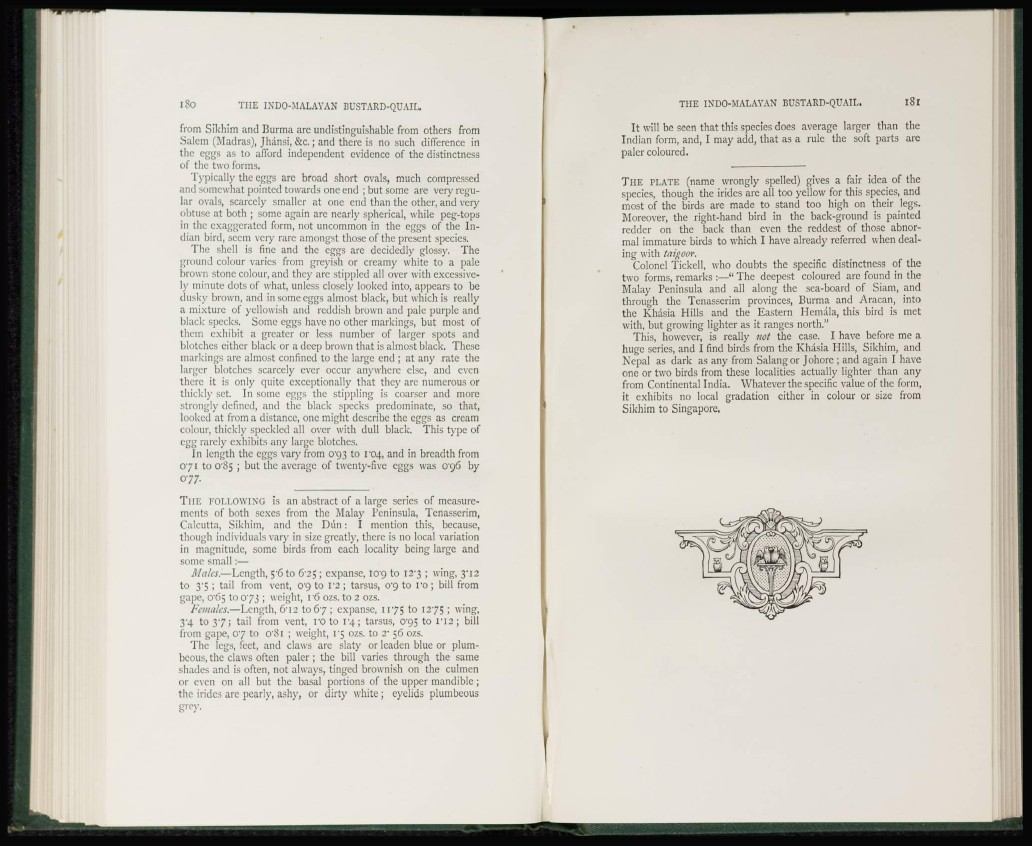
from Sikhim and Burma arc undistinguishable from others from
Salem (Madras), Jhansi, Sic.; and there is no such difference in
the eggs as to afford independent evidence of the distinctness
of the two forms.
Typically the eggs are broad short ovals, much compressed
and somewhat pointed towards one end ; but some are very regular
ovals, scarcely smaller at one end than the other, and very
obtuse at both ; some again arc nearly spherical, while peg-tops
in the exaggerated form, not uncommon in the eggs of the Indian
bird, seem very rare amongst those of the present species.
The shell is fine and the eggs are decidedly glossy. The
ground colour varies from greyish or creamy white to a pale
brown stone colour, and they are stippled all over with excessively
minute dots of what, unless closely looked into, appears to be
dusky brown, and in some eggs almost black, but which is really
a mixture of yellowish and reddish brown and pale purple and
black specks. Some eggs have no other markings, but most of
them exhibit a greater or less number of larger spots and
blotches either black or a deep brown that is almost black. These
markings arc almost confined to the large end ; at any rate the
larger blotches scarcely ever occur anywhere else, and even
there it is only quite exceptionally that they arc numerous or
thickly set. In some eggs the stippling is coarser and more
strongly defined, and the black specks predominate, so that,
looked at from a distance, one might describe the eggs as cream
colour, thickly speckled all over with dull black. This type of
egg rarely exhibits any large blotches.
In length the eggs vary from 0^93 to ro4, and in breadth from
071 to 0'85 ; but the average of twenty-five eggs was C 9 6 by
077.
T H E FOLLOWING is an abstract of a large series of measurements
of both sexes from the Malay Peninsula, Tenasserim,
Calcutta, Sikhim, and the Dim: I mention this, because,
though individuals vary in size greatly, there is no local variation
in magnitude, some birds from each locality being large and
some small:—
Males.-—Length, 5'6to &2$ ; expanse, I0'9 to I2'3 ; wing, 3 ' I 2
to 3'5 ; tail from vent, 0'9 to 12 ; tarsus, o'9 to I'o ; bill from
gape, C 6 5 to 073 ; weight, 16 ozs. to 2 ozs.
Females.—Length, 6'I2 to 67 ; expanse, 1175 to 1275 ; wing,
34 to 3 7 ; tail from vent, ro to 1 4 ; tarsus, C 9 5 to r i 2 ; bill
from gape, 07 to o'Si ; weight, l'5 ozs. to 2' 56 ozs.
The legs, feet, and claws are slaty or leaden blue or plumbeous,
the claws often paler ; the bill varies through the same
shades and is often, not always, tinged brownish on the culmen
or even on all but the basal portions of the upper mandible ;
the hides are pearl}-, ashy, or dirty white ; eyelids plumbeous
grey.
It will be seen that this species does average larger than the
Indian form, and, I may add, that as a rule the soft parts are
paler coloured.
THE PLATE (name wrongly spelled) gives a fair idea of the
species, though the irides are all too yellow for this species, and
most of the birds are made to stand too high on their legs.
Moreover, the right-hand bird in the back-ground is painted
redder on the back than even the reddest of those abnormal
immature birds to which I have already referred when dealing
with taigoor.
Colonel Tickell, who doubts the specific distinctness of the
two forms, remarks :—" The deepest coloured are found in the
Malay Peninsula and all along the sea-board of Siam, and
through the Tenasserim provinces, Burma and Aracan, into
the Khasia Hills and the Eastern Hcmala, this bird is met
with, but growing lighter as it ranges north."
This, however, is really not the case. I have before me a
huge series, and i find birds from the Khasia Hills, Sikhim, and
Nepal as dark as any from Salangor Johore ; and again I have
one or two birds from these localities actually lighter than any
from Continental India. Whatever the specific value of the form,
it exhibits no local gradation either in colour or size from
Sikhim to Singapore.